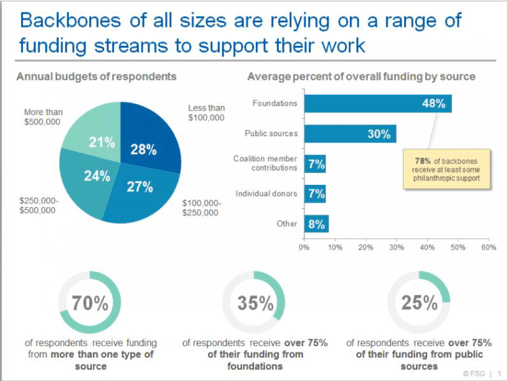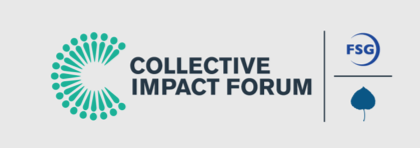 One of the most common questions we hear from collective impact practitioners is how to raise the funds needed to support and sustain the backbone role. While some funders have a nuanced understanding of the immense value of collective impact initiatives, supporting the backbone is a different approach for many philanthropic and public funding sources, which can make it challenging to get the consistent, long-term investments needed to help effect population-change.
One of the most common questions we hear from collective impact practitioners is how to raise the funds needed to support and sustain the backbone role. While some funders have a nuanced understanding of the immense value of collective impact initiatives, supporting the backbone is a different approach for many philanthropic and public funding sources, which can make it challenging to get the consistent, long-term investments needed to help effect population-change.
In March 2019, we surveyed Collective Impact Forum members to understand trends in backbone funding, what challenges organizations are facing, and what fundraising strategies are working well. The survey garnered 250 responses from backbone organizations who represent collective impact efforts focusing on diverse issues, including Education & Youth, Employment, Environment, Health & Nutrition, and several others. Respondents also covered a range of geographic focuses (roughly 70% from the US and 30% from other regions), annual budgets, and years serving as the backbone of an initiative.
While each backbone is unique, respondents had some key similarities in funding composition
- Most backbones has a diverse set of funding sources: Over 70% of respondents reported receiving funding from at least two types of sources, including foundations, public sources, coalition member contributions, and individual donors. While backbones are striving for funding diversity, foundations are the most represented source, with foundation contributions making up, on average, 48% of respondents’ revenue.
- Backbones tend to experience revenue diversification as they mature: Backbones that have served as the backbone for their collective impact initiative for 1 to 3 years reported the highest average percentage of funding from foundations (56%). The percentage of funding from foundations decreased by 25% for backbones that have served in the role for more than 5 years, at which point these backbones receive the same average percentage of funding from public sources as they do foundations.

Respondent highlighted facing similar challenges related to attracting and retaining funder support
- Perception that the backbone is “overhead” or “process”: Backbones find that funders are often more eager to fund programmatic work than what they perceive as “process”, and they often struggle to understand the backbone’s relationship to ensuring the success of the collective impact initiative’s efforts.
- Real and/or perceived competition for funding with initiative partners: Collective impact initiatives often bring together many partners who also depend on support from funders focused on their specific region or issue area. Backbones can experience pushback from partners when engaging with these same funders because of fear that resources will be reallocated.
- Funders often seek results in very short windows: Backbones are finding that funders often want to see measurable impact faster than is realistic for some of the intractable challenges their initiatives are seeking to address.
Respondents reported finding success when they are intentional about their sustainability approach based on a funder’s specific interest and clearly communicate impact
Backbones had the following recommendations for engaging with funders:
- Be very specific about what the backbone role enables: Backbones recommend being very clear that the alignment necessary for partners to go further and be more effective than they would alone would not happen without the backbone, and highlight the day to day work a backbone does that supports this new way of working.
- Speak the language of the funder: For funders who are less familiar with collective impact, backbones try to avoid jargon in their explanations and focus on tailoring their pitches to funder interests.
- Get creative about program funding: Backbone organizations sometimes partner on funding requests with initiative members and, if they win those grants, use part of the money to support the coordination and facilitation work they do to ensure program success.
- Invest in data capacity: Backbones reported being more successful getting funding when they have the ability to track both qualitative and quantitative data to demonstrate their impact, which requires dedicated measurement and evaluation resources.
- Set realistic expectations about results over time: Backbones work to educate their funders about the type of results that are realistic to expect over time. For example, most initiatives will demonstrate results around the design and implementation of their work in the early years, see progress toward systems change in the intermediate years, and population level change in the later years. For greater detail on evaluating collective impact and indicators aligned with early, middle, and later years, see this Guide to Evaluating Collective Impact.
- Think about segmenting functions to appeal to different funders: Some backbones secure funds by engaging different funders to support different functions of the backbone, like data collection, policy and advocacy, and community outreach, knowing that some funders get particularly excited about certain types of work.
Overall, in addition to making the case for funding the backbone role, initiatives find it helpful to be clear about the value-add of the collective impact approach overall. Key messages to this end include:
- Collective impact helps us achieve community-level results, not only results one program at a time
- Collective impact helps to scale what is working in on part of the community across an entire community
- Collective impact brings organizations together to change systems, not only implement programs
This blog was originally published on the Collective Impact Forum and has been reposted here with permission.
Take Your Learning Further:
Learn more about Collective Impact Forum and FSG





